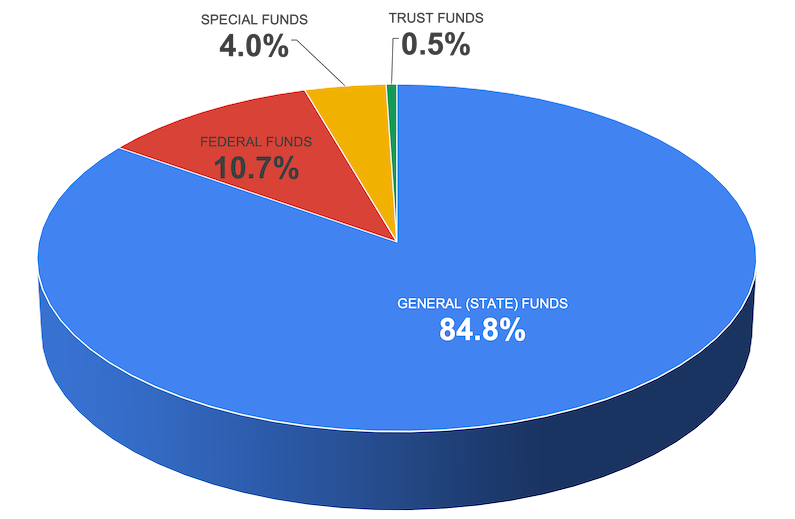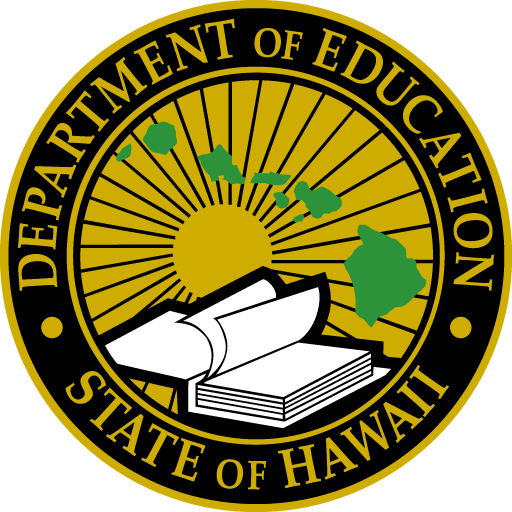The Hawai‘i State Matagaluega o Aoga’s budget plays a crucial role in supporting student success and maintaining the quality o our public school system. Our budget is divided into two main parts: the operating budget and the Capital Improvements Program (CIP) budget.
Appropriation → | → Allocation → | → Allotment → | → Expenditure |
Resources that have been or are in the process o being approved by the Legislature and have become law. (Legislative Reference Bureau – The Tala o le Tupe Process) | Appropriation amounts provided (“allocated”) to programs to create expenditures plans. Allocated amount could be less than Appropriation due to restrictions set forth by the Governor or by the Department depending on the fiscal conditions o the time. | Once the Expenditure plans are completed and approved, resources are loaded (“allotted”) into the Financial Management System allowing programs to begin spending their allotted resources. | Actual use o the resources for payroll and by either purchasing or encumbering goods or services. |
The $2.18 billion operating budget for fiscal year 2024-25, primarily funded by state tax revenue, covers the day-to-day operations o schools and ofices, from teacher salaries to classroom resources. Meanwhile, the CIP budget focuses on the development, maintenance and upgrading o school facilities, funded almost entirely through state bonds.
Together, these budgets ensure that our schools are equipped to provide a safe, engaging and effective learning environment for all students. Learn more about the Department’s budgets below.
TIMELINE
This is a timeline o major events o the Department’s operating budget appropriations.
Aso | Faalapotopotoga | Description |
|---|---|---|
5/2/2025 | Legislature | House Finance and Senate Ways and Means releases Committee Report and bill format of budget bill HB300 SD1. • Tala o le Tupe Worksheet (see EDN 100, 150, 200, 300, 400, and 500) |
4/16/2025 | Department of Taxation | The Council on Revenues held a meeting to forecast revenue growth for the General Fund on March 12th, 2025. • The Council lowered its forecast to 5.0% from 6.4% for Fiscal Year (FY) 2025. It also lowered the forecast to -2.25% from -1.5% for FY 2026. The forecast for FYs 2027, 2028, 2029, 2030, and 2031 was left unchanged at 2.9%, 3.5%, 2.6%, 1.9%, and 3.1%, respectively. • Presentation |
4/8/2025 | Legislature | Senate Ways and Means releases Committee Report and bill format of budget bill HB300 SD1. • Tala o le Tupe Worksheet (see EDN 100, 150, 200, 300, 400, and 500) |
3/11/2025 | Legislature | House Finance releases Committee Report and bill format of budget bill HB300 HD1. • Tala o le Tupe Worksheet (see EDN 100, 150, 200, 300, 400, and 500) |
1/21/2025 | Legislature | Tala o le Tupe Bill Introduced HB300 |
1/14/2025 | Legislature | Senate Committee on Ways and Means and Education budget briefing for the Matagaluega o Aoga at 1:00 PM. • Informational Briefing Notice • Briefing Materials |
1/13/2025 | Legislature | House Committee on Education Budget Briefing for the Matagaluega o Aoga at 2:00 PM. • Informational Briefing Notice |
1/10/2025 | Department of Taxation | The Council on Revenues held a meeting to forecast revenue growth for the General Fund on January 8th, 2025. • The Council increased the FY 2025 forecast and lowered the forecast for FY 2026-2029. • Presentation |
1/10/2025 | Legislature | House Committee on Finance Tala o le Tupe Briefing for the Matagaluega o Aoga at 9:00AM. • Informational Briefing Notice • Briefing Materials |
12/12/2024 | Board of EducationFinance and Infrastructure Committee meeting | Update on Governor’s Decision on FB 2025-27 Tala o le Tupe: • CIP Tala o le Tupe – Agenda Item III • Operating Tala o le Tupe – Agenda Item IV |
11/27/2024 | Department of Budget and Finance | FM 24-17 Governor’s Decisions on FB 2025-27 Executive Tala o le Tupe Requests: • FM 24-17 Attachment – EDN (Pg. 1-30) |
11/25/2024 | Hawaii State Legislature | |
11/13/2024 | Department of Budget and Finance | FM 24-16 Department of Budget and Finance’s Recommendations on FB 2025-27 Executive Tala o le Tupe Requests: • FM 24-16 Attachment – EDN (Pg. 1-25) |
10/22/2024 | Board of EducationFinance and Infrastructure Committee meeting | Proposed FB 2025-27 Tala o le Tupe: • Operating Tala o le Tupe – Agenda Item III • CIP Tala o le Tupe – Agenda Item IV |
9/26/2024 | Department of Budget and Finance | FM 24-10 Fiscal Biennium 2025-27 Executive Tala o le Tupe Request and the Program and Financial Plan for the Period 2025-31: • Attachment 1 • Attachment 2 • Attachment 3 • Attachment 4 • Attachment 5 • Attachment 6 • Attachment 7 |
9/17/2024 | Department of Budget and Finance | EM 24-04 FY 25 Tala o le Tupe Execution Policies and Instructions: • Exhibit 1 • Fa'aopoopo A • Fa'aopoopo B |
9/10/2024 | Department of Taxation | The Council on Revenues held a meeting to forecast revenue growth for the General Fund on September 5th, 2024. • While the Council expects relatively solid economic growth for the current and subsequent fiscal years, it lowered its forecast because o the significant tax relief legislation passed in the 2024 Legislature. • Presentation |
7/26/2024 | Department of Budget and Finance | FM 24-07 Program Memoranda for Major Programs in the Statewide Program Structure |
7/9/2024 | Governor | HB1800 Tala o le Tupe Bill signed into law and enacted as ACT 230, SLH 2024 • DOE programs (EDN 100, 150, 200, 300, 400, and 500) start on page 40. • GIA’s start on page 68. • Capital Improvement Projects with EDN program codes start on page 201 |
5/31/2024 | Department of Budget and Finance | FM 24-05 Review o the Program Structure and Performance Measures. • A'oga – FB 25-27 Executive Tala o le Tupe Program Structure |
Operating Tala o le Tupe
Punaoa Fa'atupe

The fiscal year 2024-25 operating budget funding comes from four sources:
- Tupe lautele: Represents approximately 85% o our funding resources. Comes from the State o Hawaiʻi’s general fund, primarily state tax revenues. This is the top source o funding to the Department.
- Tupe feterale: The second largest source o funding represents approximately 11% in expenditure ceiling resources. The Department receives grants from federal agencies including the U.S. Departments of Education, Agriculture, Defense and Health and Human Services.
- Tupe fa'apitoa: Roughly 4% o our expenditure ceiling resource is through special funds. Those coming from revenue-generating activities, including school food services, student bus transportation services, summer school program, after-school programs, adult education, driver education, and use o school facilities.
- Tupe fa'alagolago: E mafai ona aofia ai foaʻi ma meaalofa, faʻavae & isi foaʻi, aoina o polokalame taʻaloga a le aʻoga, ma le "faʻasoa talafeagai".
Fa'atupe sa'o-i-A'oga
- EDN 100 e toetoe lava fa'asoa atoa i a'oga e fa'aaoga ai le Fua Faatatau a Tamaiti Aoga (WSF). The WSF gives schools a specific dollar amount for each student, and additional funds for students with certain characteristics, such as qualifying for the free and reduced lunch program (socio-economically challenged) or being English language learners. This creates a transparent model o funding equity on a statewide basis. The balance o EDN 100 is used to support programs such as athletics, JROTC and Alternative Learning Centers.
- EDN 150 lagolago special education students who may require or have an Individualized A'oga Plan.
- EDN 400 totogi pili a'oga e aofia ai le paipa, eletise, vai, lipea, tautua mea'ai ma isi.
- EDN 500 pays for Adult A'oga programs at public schools.
Lagolago Faatupeina i Aoga, Itumalo, ma le Setete
The remainder o the budget is spread among EDNs 200 and 300, which provide support at all levels. These include instructional supports, statewide testing, administrative support (personnel, technology and fiscal), community programs such as A+ and adult education, complex area administration, the early learning ofice to provide pre-kindergarten programs, as well as the Board of Education ma Ofisi o the Superintendent.
Agencies (By EDN) that Operate Outside o the Matagaluega o Aoga
- EDN 407 Faletusi Lautele
- EDN 450 Pulega o Fale A'oga
- EDN 600 A'oga Fa'ailoga
- EDN 612 Komisi ma Pulega o Aoga
- EDN 700 Executive Ofice on Early Learning
Non-facility general fund per-pupil funding request for charter school students
The general fund per-pupil amounts, not including charter school facilities (CIP) shall be the same as the general fund per-pupil for HIDOE schools as explained in HRS 302D-28.
- The process involves two phases, first, a budget appropriation request and then later, an allocation “true-up” to adjust for any differences.
- For the budget appropriation request, the Department of Budget and Finance Director o Finance submits to the Legislature a request based on projections for consideration in the final Tala o le Tupe Appropriations Act [HRS 302D-28(a) and (b)].
- The appropriation request is reflected in the Charter School’s per pupil program.
- For the budget appropriation request, the Department of Budget and Finance Director o Finance submits to the Legislature a request based on projections for consideration in the final Tala o le Tupe Appropriations Act [HRS 302D-28(a) and (b)].
- After the Appropriations Act is finalized, the Director o Finance ensures that an allocation “true up” is done using the October 15th student enrollment count. The true up equalizes the per-pupil funding for both entities [HRS 302D-28(c)]
Capital Improvements Program (CIP)
O le Capital improvement Tala o le Tupe (CIP) budget is set by the state as part o a comprehensive program to manage state facilities, and is handled separately from the operating budget. Facilities staff work with complex area superintendents and principals to prioritize school-level needs.
Tala o le Tupe Allocations
Below are links to databases containing allocations for Department offices, districts, and schools. You can view the data by allocation number, program or organization.
